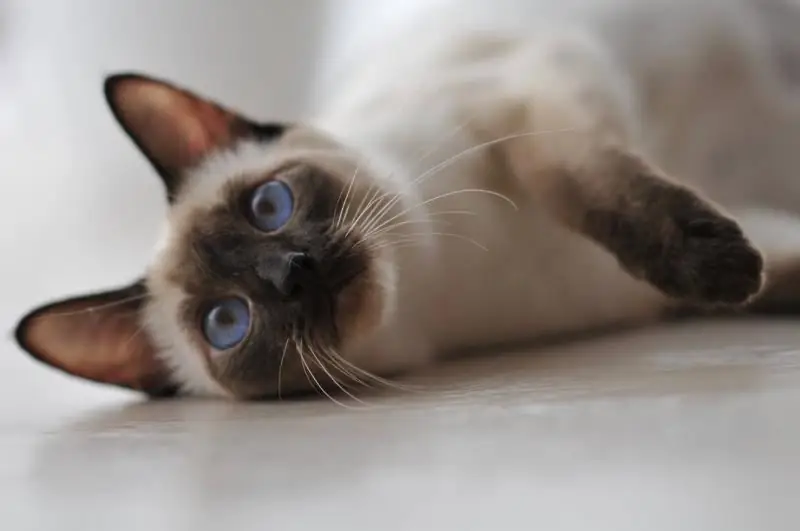
Table of contents:
- Thai cat: history of the breed, characteristics, care and breeding
- The history of the origin of the breed, its distribution and official recognition
- Characteristic physical features of a Thai cat
- The character and behavior of a Thai cat
- Thai cat health
- How to care for a Thai cat
- Breeding Thai cats
- How to choose a Thai cat kitten
- Reviews of the owners about the breed
- Author Bailey Albertson [email protected].
- Public 2024-01-17 22:26.
- Last modified 2025-06-01 07:32.
Thai cat: history of the breed, characteristics, care and breeding

Thai cats are very popular in Russia and the CIS countries. This is facilitated by their pleasant-looking rounded features, expressive blue eyes, a soft coat of a pleasant “coffee with milk” color and a developed intellect. By inertia, they continue to be called Siamese cats, which has some truth, although the modern breed of Siamese has a number of serious external differences. So, future and present owners of Thai cats will certainly be interested to learn more about these wonderful animals.
Content
- 1 History of the origin of the breed, its distribution and official recognition
-
2 Characteristic physical characteristics of a Thai cat
- 2.1 The most common colors of a Thai cat by examples (gallery)
- 2.2 How Thai cats differ from Siamese
-
3 Character and behavior of a Thai cat
- 3.1 Positive qualities and disadvantages of the breed
- 3.2 Attitude towards people and other animals
- 4 Thai cat health
-
5 How to care for a Thai cat
- 5.1 Hygiene
- 5.2 Toilet
- 5.3 Feeding
-
6 Breeding Thai cats
6.1 Castration and sterilization
- 7 How to choose a Thai cat kitten
- 8 Owner reviews about the breed
The history of the origin of the breed, its distribution and official recognition
The Thai cat is an aboriginal breed, originally from the Indian subcontinent. The earliest depictions of a cat with a characteristic phenotype date back to the 14th century and are illustrations to the ancient manuscript "Smoot-khoi" ("Book of Poems about Cats") from Ayutthaya, which contains not only images, but also detailed textual descriptions of Thai cats. The manuscript is kept in Bangkok, at the National Laboratory Museum. Over the past half a thousand years, the phenotype has practically not changed - in photographs of the late 19th century, representatives of this breed look almost the same as their modern descendants.
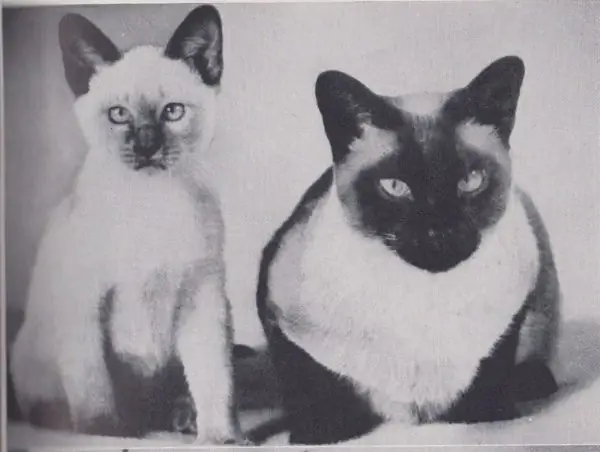
Photo from Rose Tenent's The Book of the Siamese Cat
Thai cats came to Britain at the end of the 19th century. Most likely, they were brought by members of the diplomatic mission. In 1892 the British felinologist Garrison Veer approved the standard for "royal cats from Siam". In 1901, the English Club of Siamese cats was organized, and the next year the breed standard changed significantly, approaching the modern one.
It is important to note here that the breed, known today as Thai, was originally called Siamese, according to the name of the country of origin, however, through the efforts of breeders, the representatives of this breed received a number of significant differences, so that the modern Thai cat is a Siamese cat of the old, original type.
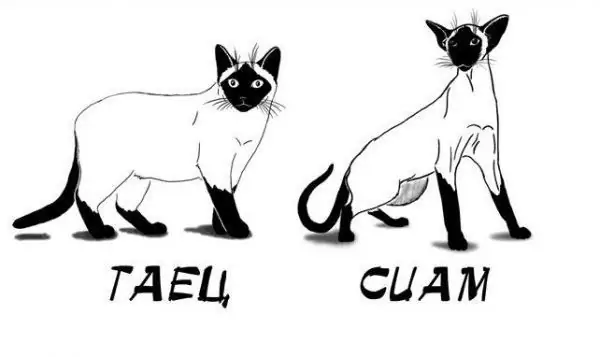
An image that clearly illustrates the characteristic differences between Thai and Siamese cats
Siamese cats of the modern type were brought to America, where, as a result of further selection, the final phenotypic separation of Siamese and Thai cats took place. The original phenotype was preserved in Siam itself and, interestingly, in Russia, where Siamese cats appeared at the end of the 18th century. The meeting with them was described by Peter Pallas, who traveled through the southern provinces of the Russian Empire in the second half of the 18th century. The cats he met lived in the Caspian village of Insar. They had a very dark color, but this is associated with a colder climate, because the coat color of Siamese cats depends on the ambient temperature.
Officially, Siamese cats came to Russia as a gift to Nicholas II from Chulalongkorn, King of Siam. Then the emperor was sent two hundred Siamese cats of the original phenotype, which became the basis of the population of these animals in Russia. Despite the fact that the official selection of representatives of this breed began only in the 80s of the twentieth century, they lived in many families, and they preferred to knit representatives of this breed with similar animals, so that the breed retained its purity.

A characteristic representative of the breed of Thai cats of the original phenotype
The breed standard was officially included in the WCF system in Germany in 1990. The name of the breed was chosen in honor of the modern name of the Kingdom of Siam - Thailand.
The breed is considered closed, but with the participation of the local felinological club and independent experts, an outbred animal that meets the established breed standards can be recognized as purebred and receive a zero pedigree.
Characteristic physical features of a Thai cat
Thais are slender, fit, have pleasant, rounded outlines, well-developed muscles and a very soft coat without undercoat. They are not prone to gaining excess weight, on the contrary - in most cases they are quite miniature. They weigh on average from 3 to 8 kg, the height at the withers is about 30 cm.
Acromelanic color is a unique feature of Thai and Siamese cats. The colored parts are usually the feet, tail and muzzle. The main part of the body is predominantly white, the shades of which can vary in very wide ranges, from almost white to chocolate. The only consistent feature is blue eyes.
Examples of the most common colors of Thai cats (image gallery)
-

Purple point - Lilac point: body color - glacial white. No shading. The points are frosty gray with a pinkish tone. Lavender pink nose and pads
-

Seal point - Seal point: body color - from pale deer (pale fawn, light beige) to creamy beige (creamy beige), warm tone. Shading to match the points. The points are of a deep seal brown color, almost black. The nose and paw pads are the same color as the points
-

Blue point - Blue point: body color - bluish white, cold tone. Shading to match the points. The points are a deep bluish gray. Dark slate nose and paw pads
-

Caramel point tortoiseshell - Caramel point: body color - white magnolia (meaning the flower of magnolia). Shading to match the points. The points are brownish gray. The nose and paw pads are pinkish slate. The animal in the photo still has an admixture of tortoiseshell
-

Chocolate point - Chocolate point: body color - ivory. No shading. Milk chocolate points, warm tone. Cinnamon pink nose and paw pads
There are also other points: gray-brown, cinnamon, fawn, red, cream, torti and brown. Each of them has several shades, but when viewed from the side, these are all more or less dark shades of white, with various repressions of other colors. Solid, that is, monochromatic animals, are found, but extremely rare. There is a tortoiseshell point - tricolor cats, with white, black and red spots in the painted parts of the body. There are also tabby - colored body parts they have a characteristic striping.

Thai cat, cream solid, with characteristic tabby stripes
How Thai cats differ from Siamese
Through the efforts of breeders, Siamese have acquired extremely sophisticated, pointed features. The body of the Siamese is more elongated and graceful, while the Thais look more massive, have a denser skeleton. Siamese legs are thinner and more elongated. The tips of the ears of the Siamese are pointed, that of the Thais are rounded, the ears of the Siamese cats themselves are noticeably larger. The muzzle of the Siamese has a wedge-shaped elongated shape, while that of the Thais is rounded. Siamese eyes are sharper, almond-shaped, while Thais have a rounded shape.
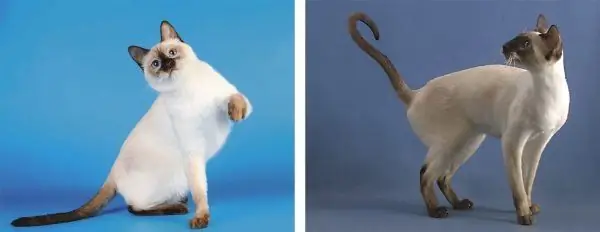
In the photo on the left is a Thai cat, on the right is a Siamese
The character and behavior of a Thai cat
There is a widespread stereotype about the bad character of the Thai cat, its aggressiveness and rancor. In fact, such traits can appear in offspring obtained from a Thai cat and a street cat. Even with the inheritance of the characteristic acromelanic color and blue eyes, such animals often have a bad temper.
Through the efforts of breeders and felinologists, thoroughbred Thai cats are spared the negative consequences of their "outbred" past. Today, by their nature, Thais are considered one of the most affectionate and docile cats, which are very attached to their owners and are perfectly trainable.

Animal rearing is best done from an early age.
Positive qualities and disadvantages of the breed
It is believed that cats cannot be trained, but in the case of Thai cats this is not the case. These animals are unusually very intelligent and, with proper education in childhood itself, they can be trained to carry out various commands, for example, "bring".
Thais are very mobile from an early age. Compared to representatives of other breeds, they sleep one and a half to two times less. This is especially noticeable in childhood. Thai kittens are constantly climbing somewhere and playing with something. Curiosity is one of the key qualities of this breed. Together with playfulness, it persists throughout life.

Thais are considered one of the smartest domestic cats.
Thanks to their energy and intelligence, they are excellent mouse-catchers.
An unusual quality of Thais is empathy. They perfectly feel the emotional state of the owner and actively try to console him in case of sadness: lick, fondle, in every possible way "persuade" to calm down - their intonation range is very wide.
Negative qualities include the absence of fear, which, together with curiosity, can push the animal into dangerous research. There are cases when Thais jump out of windows, hunting birds, or leave the apartment through open doors, wanting to study the front door. They can touch the switched on gas burner with their paw or "dive" into the toilet. This should be remembered and, if possible, limit such opportunities for the animal.

Curiosity often pushes Thai cats to rash acts, so it is better not to leave them near open windows unattended.
Also, the independence of this breed is referred to as negative qualities. Thais do not tolerate being subjected to force or being forced to do something against their will. They are not inclined to take revenge, but you can forget about favoring the "offender". This is the difficulty of raising cats - it is important to observe the "balance of what is permissible", which is individual in each case.
Attitude towards people and other animals
For lonely people, this is the most faithful and devoted friend - the Thais become attached to the owner, accompany him in all matters. It will not be possible to give away an adult animal - these cats are very sensitive, and, having once chosen an owner, they will not be able to reorganize. But they can easily change their place of residence together with the owner.
These cats love to "talk" - they often meow and purr about something, being able to make many different sounds. The rest of the family is treated well, but they do not like any violence against themselves. For the same reason, they are wary of children, but in no way hostile. Often, Thai cats are the most gentle creature that does not mind active gripping at all.

Thai cats are not at all averse to "talk"
Thais avoid strangers, but over time they still make contact, if the person does not violate the "personal space" of the animal - does not try to forcefully pick it up or stroke it. They get along well with other pets, although excessive playfulness and hunting instincts can lead to undesirable consequences when closely interacting with birds and rodents, so it is better not to leave them alone.
Thai cat health
Compared to many other purebred cats, Thais have excellent health and strong innate immunity. To maintain good condition, it is enough to monitor the nutrition of the animal, vaccinate it in a timely manner and examine it at the veterinarian at least once a year.
Representatives of this breed are considered centenarians: on average, they live up to 15 years, however, it is not uncommon to be 20 years old or more. The maximum recorded age of a Thai cat is 28 years.
The representatives of this breed have genetic diseases. These are squint and tail fractures. Healthy parents are very unlikely to have sick offspring, so if you want to make sure that there are no hereditary diseases in animals, examine their parents or ask for their medical record.
Strabismus may appear slightly in childhood and disappear later. And it can appear in an adult animal, as a result of severe psychological stress. In both cases, it is best to consult a veterinarian.
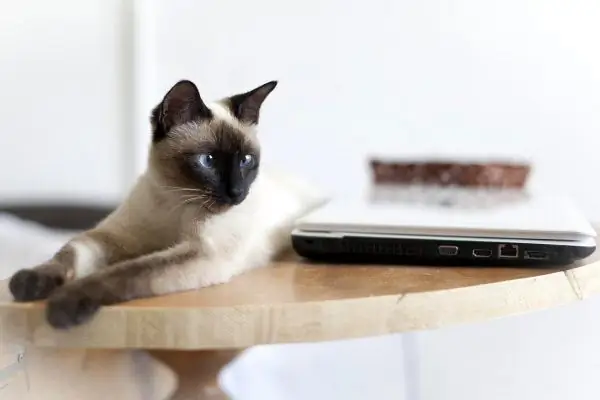
A favorable emotional climate in the area of its habitat will help to avoid the development of strabismus in a Thai cat.
Breaks, knots and hooks on the tail used to be considered a characteristic feature of the representatives of this breed, but later it turned out that this is a deformity of the spine, which is very painful for animals. Animals experiencing constant pain often behaved aggressively, giving rise to myths about the characteristic aggressiveness of all representatives of the breed. Today, breeders have practically saved animals from the hereditary manifestations of this disease.
How to care for a Thai cat
Thais do not require special attention to themselves in terms of care. It is enough to simply observe basic hygiene, occasionally comb the animal's fur and monitor its nutrition. The latter is especially important, however, all the components are important in care, so you should not neglect them.
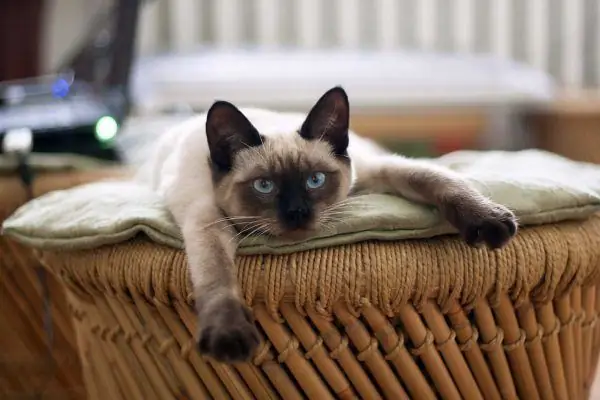
Thai cats are quite unpretentious in everyday life
Hygiene
Thai cats love to bathe, but you shouldn't do it often - once a month will be more than enough. When bathing, if your veterinarian does not recommend otherwise, you can use any shampoo for cats.
Ears should be cleaned as soon as they become dirty. As a rule, once a week is sufficient. Cleaning can be done with ordinary ear sticks. Before cleaning, the sticks should be slightly moistened with hydrogen peroxide and squeezed so that they are slightly damp. The structure of the cat's ear will not allow you to damage it, but you also do not need to insert the wand with excessive effort.
Thai cats are advised to brush their teeth. You can find a toothbrush and special toothpaste at any pet store. It must be cleaned once a month.
Clipping the claws may not be necessary at all. Being properly brought up, Thais are very tactful, with a scratching post they are not inclined to sharpen their claws on furniture, and during games they do not release their claws. But if your pet still needs to trim the claws, carefully expose the claw and cut the tip by 1-2 mm without touching the pinkish core of the claw. You can use nail clippers or nail clippers available at pet stores to trim.

Taking care of your Thai cat doesn't take a lot of time
Thais are short-haired, also without undercoat, so you don't need to comb them very carefully. Is that during the molting period. The rest of the time, one brushing per month with a stiff bristled brush is sufficient. In addition, you can periodically stroke the cat with a damp hand, thus collecting excess hair.
Restroom
In terms of organizing a latrine, the Thais represent no exceptions - it all depends on the individual preferences of the cat and its owner. We can only recommend the use of trays with high sides or closed ones, so that the filler is not scattered during burial.
Earthen clumping or silica gel absorbent compositions can be used as filler. The former will be somewhat cheaper, but they are a little dusty. The latter are much more expensive, but they better retain the unpleasant odor and do not get dusty. You can choose based on your budget, personal experience and the preferences of the animal itself.
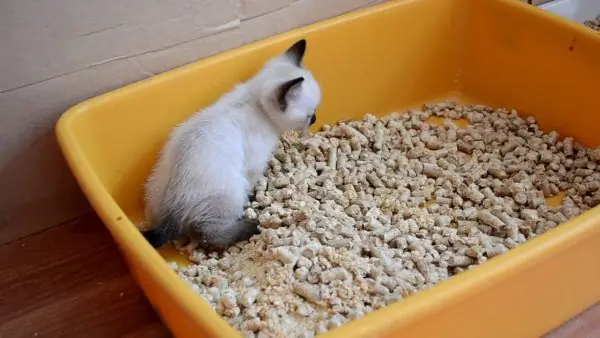
Thai cats have no difficulty in litter box training
Feeding
This is the most important component of cat care. The health of the animal and its life expectancy directly depend on proper nutrition.
Never feed the animal from the table. Fatty, spicy, salty, sweet, cereal, yeast foods are contraindicated for cats, that is, most of those foods that people usually consume.
There are two main feeding options: home cooking and industrial food.

Nutrition is the main factor affecting animal health
For an adult animal, nutrition with dry industrial extra premium food is optimal. Their cost starts at about $ 10 per kg, but they do not contain unnecessary food additives, such as cereals, but they contain natural proteins, vitamins and trace elements, and in balanced proportions. For most animals, Pro Plan, Pronature or similar food grade will do. But the popular Royal Canin in the past couple of years has significantly deteriorated the quality of its products, so it is not recommended to use it. The dosage depends on body weight and is indicated on the package.
Home cooking can include baked or stewed vegetables and fresh herbs such as courgettes, carrots, beets, pumpkin, broccoli, parsley, lettuce, and dill. However, the main element of the diet should be lean meat, optimally chicken that has undergone heat treatment. You can also dilute your pet's diet with medium-fat fermented milk products.
Please note that bones should not be given to cats, since cats do not chew food, as a result of which bones can injure the insides of the animal.
With natural feeding per day, the cat should absorb about 5% of its own weight. So, with a weight of 5 kg, the animal must consume 250 g of food. This mass can be distributed over 150 g of meat, 50 g of fermented milk products and 50 g of vegetables. Each meal can be flavored with a couple of drops of cold-pressed unrefined vegetable oil. Divide it all into two meals a day and the menu for your cat is ready.
Note that Thai cats have an interesting feature - eating seafood tends to darken their fur.
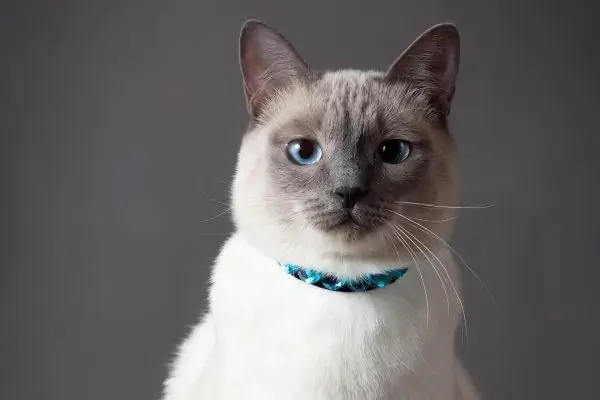
For good health and beautiful appearance, the animal's nutrition should be as balanced as possible.
Breeding Thai cats
The Thai cat belongs to the "oriental" breeds, which are characterized by early puberty. So, the first estrus in a cat can happen at 4-6 months, however, if you want to engage in breeding, mating can be done after a year of life. Many experts advise taking the animal for mating after the third heat.
The fact is that due to the genetic characteristics of the species, the reproductive system is formed before the formation of the organism as a whole ends. So early pregnancy can negatively affect the health of the animal, in particular, there may be problems with the spine. In addition, the cat can give birth to non-viable offspring. She may also develop dysfunctions of the reproductive system.

To find a mating partner, you should contact your local feline club or look at thematic exhibitions
To untie the animals, they are brought together with experienced partners. Mating is carried out on the territory of the cat. If we are talking about pedigree breeding, then a mating agreement is preliminarily concluded between the owners of the animals. Animals must be vaccinated, free from parasites and undergo a medical examination. Cats are also trimmed their claws so that they cannot seriously injure each other in the process of "acquaintance".
The mating process takes 3-5 days. The success of the event can be judged by the behavior of the cat - if she stops pawing the cat and allows herself to be licked, then the mating has taken place. However, do not rush to pick up the cat in a day - cats can mate many times, which increases the likelihood of pregnancy. If the cat has lost interest in the cat, the mating is complete.
It is possible to determine the pregnancy of a cat in 3-4 weeks. Her character becomes calm and even phlegmatic, she begins to eat more, she may feel sick, her forms are rounded. Precisely the fact of pregnancy can be diagnosed in a veterinary clinic using ultrasound. Pregnancy lasts about 9 weeks. There can be up to 5 kittens in one litter.
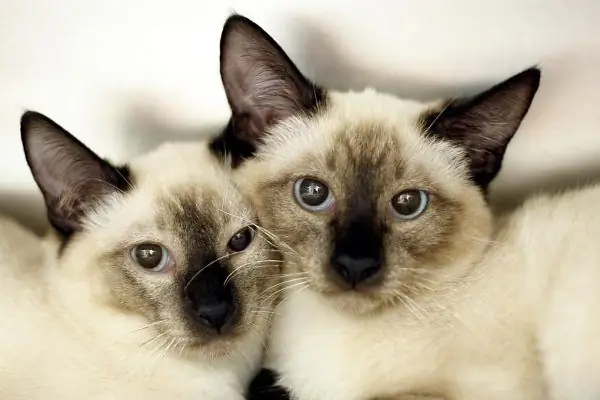
Thai cats have strong enough parental instincts, so that males often take part in raising offspring.
Castration and sterilization
If breeding is not foreseen, it is better to castrate the animal. The operation is performed by a veterinarian at home under general anesthesia. The operation itself will take up to 20 minutes; the animal can recover from anesthesia up to 20 hours. For this period, it must be left completely alone by placing a bowl of water next to it.
For males, the consequences are simpler - in 2-3 days the animal completely returns to normal behavior, and the incisions heal within a week. Licking incisions is allowed. For females, the consequences are a little more complex. They put on a postoperative blanket to exclude the possibility of licking the incision sites. Pain medications are administered within 3-5 days after the operation. Full recovery takes up to 2 weeks.
Castration is advised to be carried out after puberty of the animal. For males it is 8-10 months, for females 6-10 months. Earlier than six months of age, castration is not advised, while it is better to castrate a cat before the first estrus - thus, the risk of developing breast cancer will be minimized. In this case, everything is purely individual, so to make a final decision, consult your veterinarian about this.
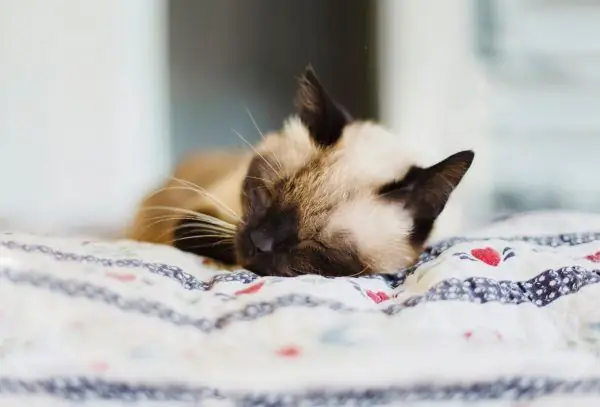
During recovery from anesthesia, it is important to ensure that the animal does not interfere with breathing freely
How to choose a Thai cat kitten
Kittens are best taken at the age of 3 months - they have already stopped breastfeeding, have undergone primary vaccination, they were probably bathed and combed at least once, clipped their claws and brushed their teeth. For kittens, these are important emotional moments - their future attitude to all these procedures largely depends on first impressions, so it is better when an experienced breeder performs them for the first time.
At the same time, at 3 months, kittens still lend themselves well to education and training, they continue to develop behavioral reactions and attachments are formed. So this is the optimal age to pick up a kitten from breeders.
Attention must be paid primarily to the health of the fluffy. He should be active and cheerful, he should not have any discharge from the eye, nose or anus. The ears and fur should be clean, the throat should be pink.
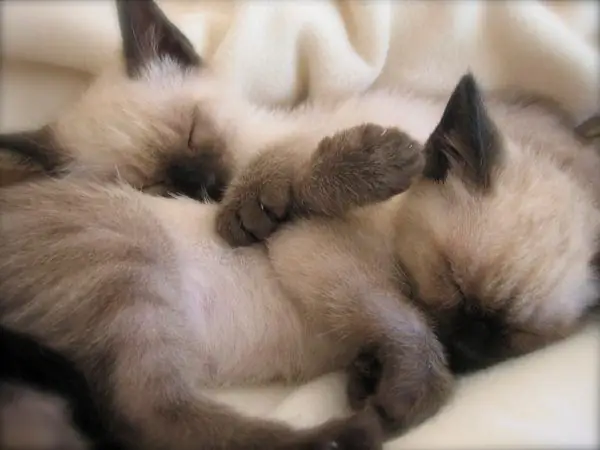
Thai kittens sleep about 2 times less than representatives of other breeds
Take a look at the kitten's parents too. Pay special attention to whether they have strabismus and straight tails - these are possible genetically transmitted diseases. Well, in general, a look at the parents will allow you to understand how the kitten will grow approximately in the future.
If you want a more caring and calm creature who needs to spend more time around, choose a kitty. If you are attracted by independence and activity - choose a cat, they are also more "talkative".
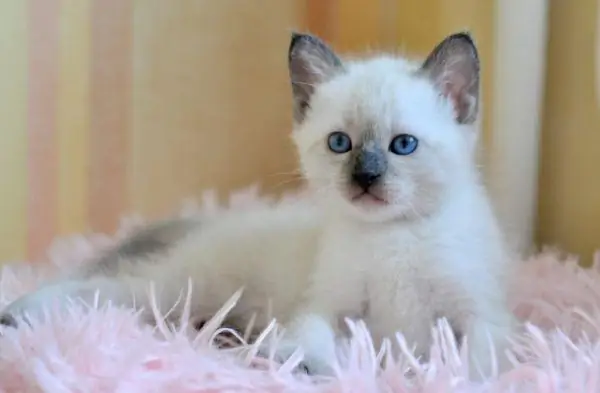
Thai kittens very quickly adapt to a new place of residence
Reviews of the owners about the breed
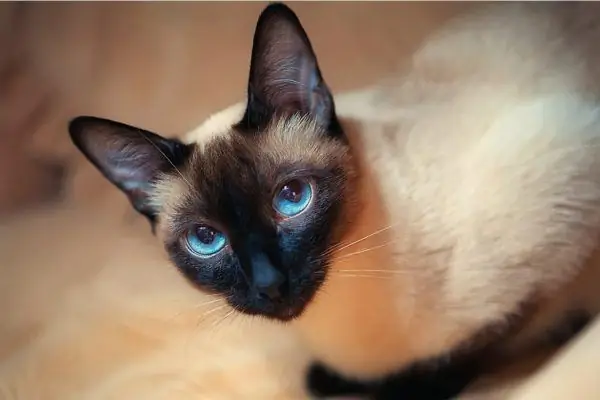
You cannot find negative reviews about representatives of this breed.
Thai cats are smart, loyal and affectionate companions. With them there is a minimum of hassle in terms of care, they perfectly adapt to any climate, have good health and, provided they are properly nourished, can live a very long cat life. They are very active by feline standards and remain playful their entire lives. In a word, wonderful animals capable of becoming a faithful companion for a long time.
Recommended:
Bengal Cat: Description Of The Breed, Character And Habits, Photos, How To Choose A Kitten, Reviews Of The Owners Of A Home Bengal
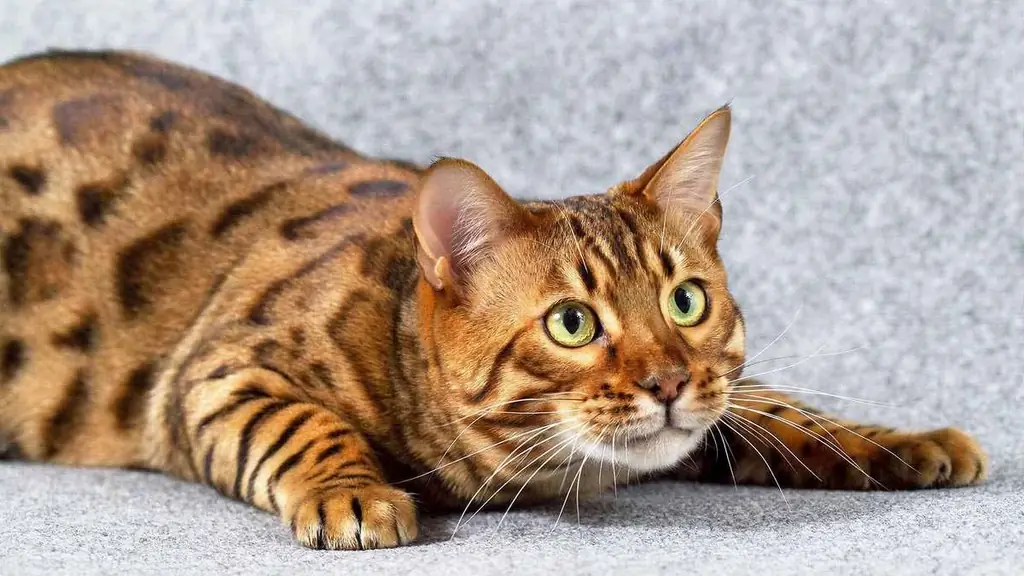
The origin of Bengal cats. External description of the breed. Features of the acquisition. The character and behavior of Bengals. The specifics of caring for a Bengal cat. Reviews
Siamese Cat: Description Of The Breed, Character And Habits, Owner Reviews, Photos, Kitten Selection, Difference From Thai Cats
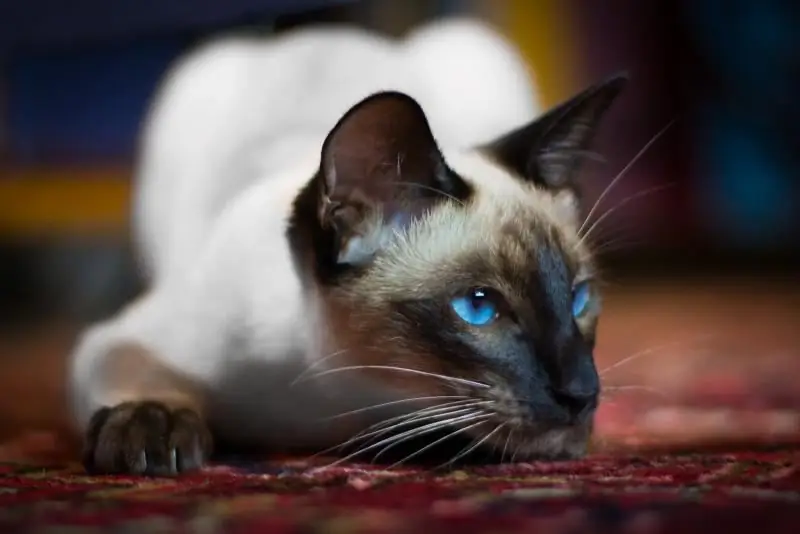
Everything you need to know about the Siamese cat: the history of the breed, how Siamese cats differ from Thai cats, how to care for them, how to choose purebred kittens
Chausie: Description Of The Breed, Character And Habits Of A Houseie Cat, Photo, Choice Of A Kitten, Reviews Of Cat Owners
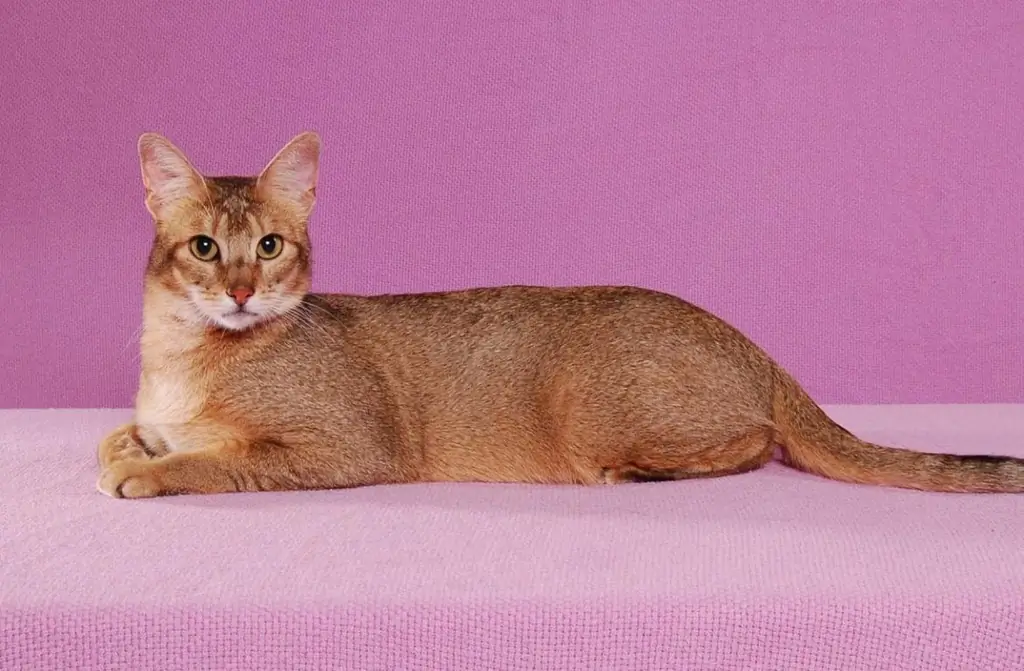
The history of the origin of Chausie. Breed standard. Character, behavior, health. Features of nutrition. Tips for choosing a Chausie kitten. How to breed. Reviews. Video
Belgian (Bengal Cat): Description Of The Breed, Character And Habits, Maintenance And Care, Owner Reviews, Photos
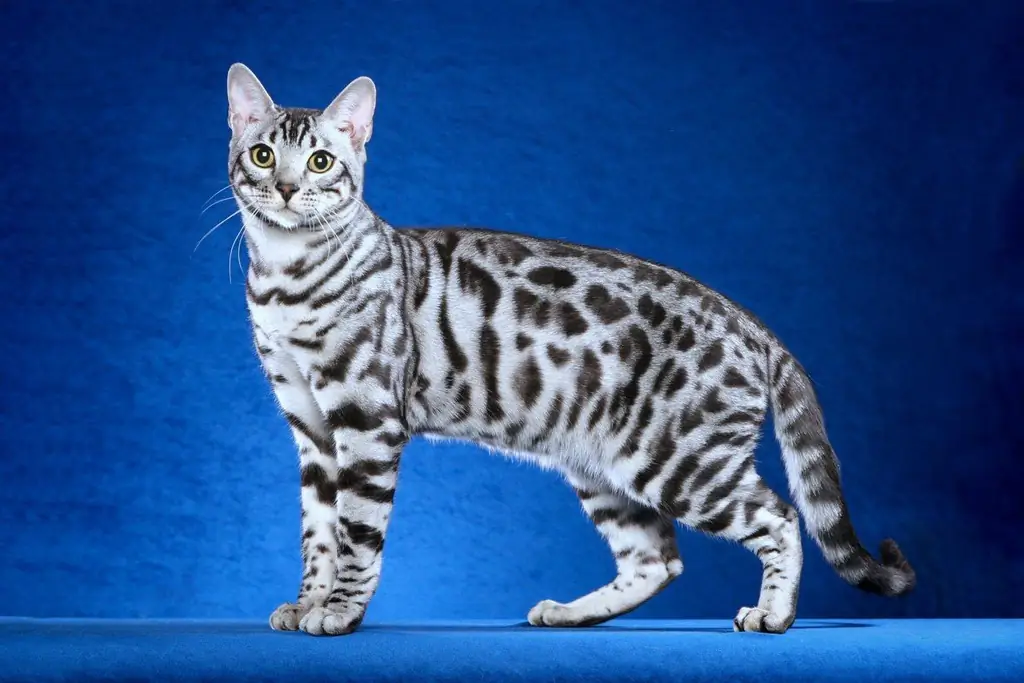
The history of the origin of the breed. The appearance of a Bengal cat. Bengal character. Health. How to take care of your pet. How to choose a kitten. Reviews
Cornish Rex: Description Of The Breed With Photos, Character And Habits, Care And Maintenance, Reviews Of Cat Owners
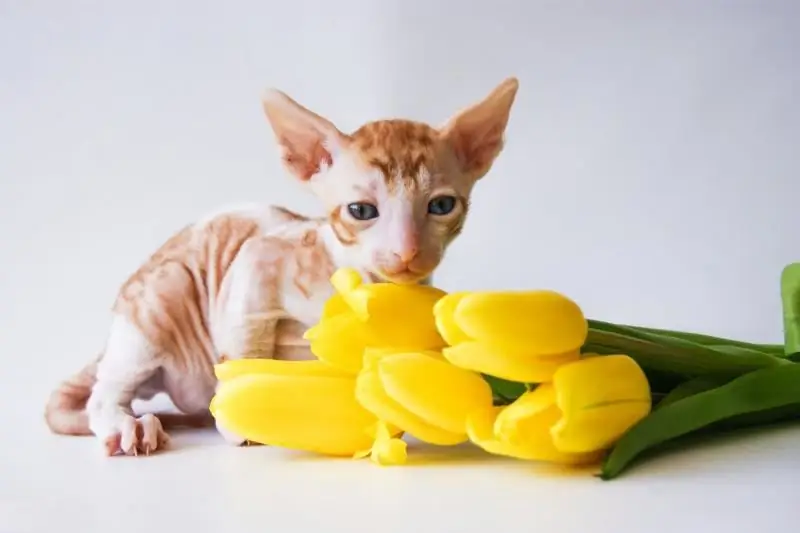
The history of the origin of the breed. What does a Cornish Rex look like? The nature of the cat. Care rules. What to feed the Cornish Rex. Reviews, photos and videos about the breed
